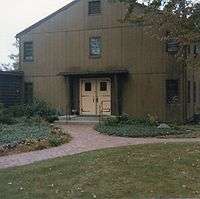St. Gregory's Abbey, Three Rivers


St. Gregory's Abbey, located near Three Rivers, in St. Joseph County, Michigan, is a community of men living under the Rule of St. Benedict within the Episcopal Church.
History

In 1935, a group of American Episcopalians went to England to be trained by the Anglican Benedictines of Nashdom Abbey in Buckinghamshire. Some of this group returned to the US, became life-professed monks, and in 1939 formed St. Gregory's House in Valparaiso, Indiana. It soon became St. Gregory's Priory.
The monks initially gained their living by taking charge of three mission churches in Episcopal Diocese of Northern Indiana under Bishop Campbell Gray. The three missions were: St. Stephen's in Hobart, St. Andrew's in Valparaiso and St. Augustine's Episcopal Church in Gary,Indiana. In 1946, the community moved to a rural setting near Three Rivers, Michigan and grew considerably under the leadership of Dom Paul Severance.
For 30 years, the monastery was a dependency of Nashdom Abbey and relied on the careful shepherding of its abbots. In 1969 St. Gregory's became an independent abbey, and the community's Prior, Benedict Reid, was elected first Abbot. In 1989, Andrew Marr was elected his successor.
How the monks live
The monastery housework is done by the monks. This includes a good deal of outside work such as landscaping, gardening, and grounds maintenance.
There are classes for the monks; correspondence to answer; and sermons, retreats, and special ministries to prepare for. Community members occasionally minister in parish churches and other religious houses, and retreats are conducted at the Abbey. The frequency of external activities incidental to the normal life of a monk is regulated by the necessity of preserving Benedictine life.
Work, study and prayer are the main activities, with prayer being the most important. The conventual Eucharist is the center of each day. In the past, the monastery celebrated the Tridentine Mass in Latin, but Mass is now celebrated from the 1979 Book of Common Prayer and with the celebrant facing the congregation.
References
Further reading and viewing
- Wells, Wallace L. “Prayerful and Militant.” The Living Church 140.3 (1960): 12.Print.
- Wiseman, Frederick (director) (1972). Essene (motion picture).